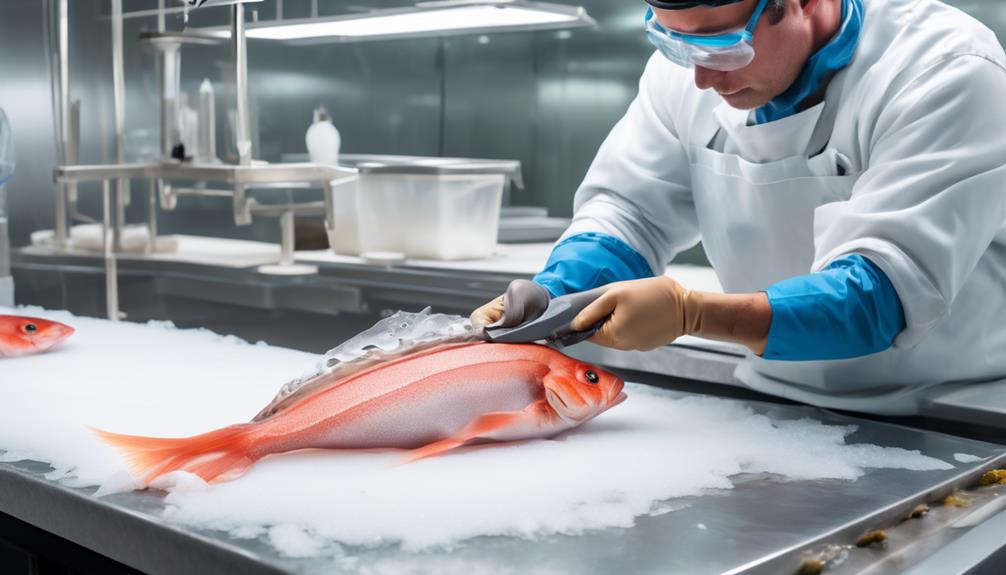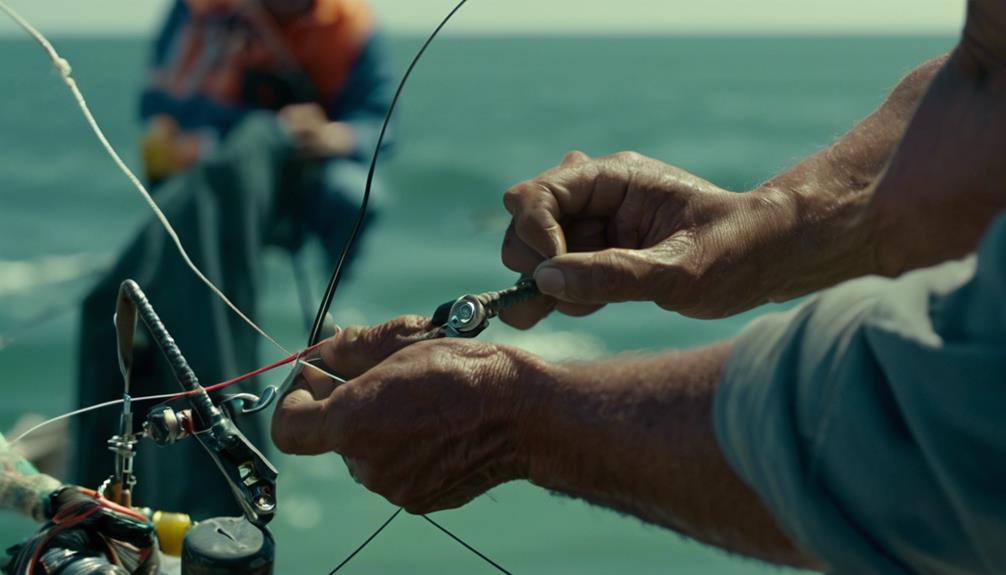Imagine standing on the edge of a vast, shimmering ocean, the warm sun beating down on your skin and the salty breeze tousling your hair. Now, imagine the thrill of hooking into a powerful saltwater fish, feeling the line zing as it races away from you.
If you want to experience the excitement and satisfaction of saltwater fly fishing, you'll need to master the essential techniques and strategies that make this sport so rewarding. From selecting the right gear to understanding the nuances of tides and locating elusive fish, these top 10 tips will help you elevate your saltwater fly fishing game and increase your chances of success on the open water.
Gear Selection
When selecting gear for saltwater fly fishing, prioritize durable and corrosion-resistant equipment to withstand the harsh marine environment. For rod selection, opt for a fast-action, saltwater-specific fly rod. These rods are designed to handle larger fish and strong winds commonly encountered in saltwater environments. Look for rods made of materials such as graphite or fiberglass, as they offer the strength and flexibility needed for saltwater fly fishing. Additionally, consider the length and weight of the rod based on the type of fishing you plan to do—whether it's onshore, nearshore, or offshore.
When it comes to reel options, choose a saltwater fly reel with a fully sealed drag system to prevent salt and sand from causing damage. Look for reels constructed from anodized aluminum or stainless steel, as these materials provide excellent corrosion resistance. A large arbor reel is beneficial for saltwater fishing as it allows for faster line retrieval and provides more space for fly line and backing, which can be crucial when battling powerful saltwater species. Consider the reel's drag system, as saltwater fish are known for their strong, initial runs. A reliable, smooth drag system is essential for controlling and landing these hard-fighting fish.
Understanding Tides
Understanding tides is crucial for successful saltwater fly fishing, as it significantly impacts the movement and behavior of fish in coastal areas. Tidal patterns dictate when and where fish are most likely to be feeding, making it essential for anglers to grasp the relationship between tides and bait movement.
Tidal patterns influence the movement of baitfish, crabs, and other marine creatures that form the primary diet of many saltwater game fish. As the tide rises and falls, these organisms are carried along with the water, attracting predatory fish to feed in specific areas. Understanding the timing of these movements allows fly fishers to position themselves strategically to intercept feeding fish.
When the tide is incoming, baitfish often move closer to shore, seeking protection in shallower waters. This movement draws in predatory fish, creating prime feeding opportunities for fly anglers. Conversely, during the outgoing tide, baitfish are swept away from the shore, prompting predatory fish to follow and feed. By recognizing these patterns, anglers can adjust their fishing locations and techniques to capitalize on the behavior of the fish.
In essence, comprehending tidal patterns is akin to unlocking the rhythm of the coastal ecosystem. It provides valuable insight into the movements of baitfish and the subsequent behavior of game fish, enabling fly fishers to anticipate and capitalize on feeding opportunities. Therefore, mastering the ebb and flow of tides is indispensable for maximizing success in saltwater fly fishing.
Locating Fish
To improve your success in saltwater fly fishing, you must focus on locating fish in their feeding zones. Understanding fish behavior and habitat selection is crucial for finding them in the vast expanse of the ocean. Here are three key tips to help you locate fish more effectively:
- Fish Behavior and Habitat Selection: Different species of fish have specific habitat preferences. Understanding their behavior and preferred habitats will greatly enhance your chances of locating them. For example, predatory fish like barracuda and tarpon often lurk near drop-offs and underwater structures, while bonefish and permit are commonly found in shallow flats and sandy areas. Researching the behavior and habitat preferences of your target species will give you a significant advantage in locating them.
- Water Conditions: Pay close attention to water conditions, such as clarity and visibility. Fish are more likely to be found in areas with good visibility where they can easily spot prey. Look for signs of baitfish, such as birds diving or surface disturbances, as these indicate potential feeding zones. Additionally, understanding how water movement and tidal currents affect fish behavior will help you pinpoint their locations more accurately.
- Use Polarized Sunglasses: Invest in a good pair of polarized sunglasses to improve your ability to spot fish in varying water conditions. Polarized lenses reduce glare and allow you to see through the water's surface, making it easier to locate fish, especially in shallow areas.
Casting Techniques
Having located the fish, your next step is to master effective casting techniques to present your fly accurately and enticingly. Line control is crucial in saltwater fly fishing. Ensure that you have a good grip on the fly line and maintain control throughout the casting process. One of the most common mistakes is allowing too much slack in the line, which can result in a sloppy presentation and decreased chances of a successful hook-up. Practice maintaining tension in the line to improve your casting accuracy and control.
Wind management is another critical aspect of saltwater fly fishing. The wind can greatly affect your casting ability and the behavior of the fly once it lands on the water. When casting into the wind, it's essential to adjust your casting angle and power to compensate for the wind resistance. Additionally, be mindful of how the wind may impact the drift of your fly once it's on the water. Understanding how to use the wind to your advantage can significantly improve your success in saltwater fly fishing.
Incorporating these casting techniques into your saltwater fly fishing repertoire will greatly enhance your chances of a successful and enjoyable fishing experience. Practice line control and wind management regularly to become proficient in these essential skills.
Fly Selection
When selecting flies for saltwater fly fishing, consider the prevalent baitfish and crustaceans in the area to match the hatch and attract the attention of the target species. Fly selection plays a crucial role in saltwater fly fishing success.
Here are some tips to help you choose the right flies for your next saltwater adventure:
- Understand the Prevalent Baitfish and Crustaceans: Before heading out, research the prevalent baitfish and crustaceans in the area where you'll be fishing. Understanding the local forage will allow you to choose fly patterns that closely resemble the natural food sources of the target species.
- Fly Tying: Consider learning the art of fly tying. This skill will give you the freedom to create custom patterns that perfectly match the local baitfish and crustaceans. It allows you to tailor your flies to the specific conditions and species you'll be targeting.
- Species Specific Patterns: Different species of saltwater fish have specific feeding habits and preferences. Invest in a selection of species-specific patterns tailored to the fish you aim to catch. For example, if you're targeting bonefish, having a variety of bonefish flies in your arsenal will increase your chances of success.
Retrieval Methods
Understanding the prevalent baitfish and crustaceans in the area won't only guide your fly selection but also influence the retrieval methods you use in saltwater fly fishing. Matching the retrieve to the behavior of the baitfish is crucial for success. For example, if the baitfish are darting and erratic in their movements, a fast and erratic retrieve may be more effective. On the other hand, if the baitfish are moving slowly, a slower and more methodical retrieve might be the key to enticing a strike.
In addition to bait behavior, water conditions play a significant role in determining the most effective retrieval methods. In calm and clear waters, fish may be more easily spooked, requiring a more delicate presentation. In contrast, in choppy or murky waters, a more aggressive retrieve may be necessary to grab the attention of the fish. Adjusting your retrieval method based on these conditions can greatly improve your chances of hooking a fish.
Line management is essential for effective retrieval. Maintaining the right amount of tension on the line while stripping in the fly is crucial for detecting strikes and setting the hook. Developing good line management skills will enhance your presentation skills and increase your chances of a successful hook-up.
Fighting and Landing Fish

To effectively fight and land fish while saltwater fly fishing, it's crucial to maintain a balanced pressure on the line and keep a steady tension to tire out the fish. When a fish takes the fly, it's important to keep the rod tip low and maintain a bend in the rod to absorb the shock of its initial run.
Here are a few key tips to help you successfully fight and land fish:
- Reel control: As the fish makes its runs, use your reel to control the line tension. When the fish runs, let the reel slip a little, and when it pauses, use the reel to regain line. Keep the line tight enough to maintain control, but not so tight that it snaps under pressure.
- Fish behavior: Understanding the behavior of the fish you're targeting can greatly improve your chances of successfully landing it. Different species have different fighting characteristics, so it's important to know how your target fish is likely to react when hooked. This knowledge will help you anticipate its movements and adjust your tactics accordingly.
- Patience and technique: Landing a fish on a fly rod requires patience and finesse. It's important to remain calm and avoid overpowering the fish. Use smooth and deliberate movements to guide the fish towards you, taking care not to rush the process. Keep the rod bent and let the fish tire itself out, then gently bring it closer for a successful landing.
Environmental Awareness
Maintaining environmental awareness while saltwater fly fishing is essential for preserving the delicate marine ecosystem and ensuring the sustainability of fish populations. By adopting eco-friendly practices, you can minimize your impact on the environment and contribute to marine conservation efforts.
When fly fishing in saltwater, it's important to be mindful of the marine life and habitats that surround you. One of the key eco-friendly practices is to use barbless hooks, which can reduce harm to fish and make it easier to release them unharmed. Additionally, practicing catch and release fishing helps conserve fish populations, allowing them to reproduce and maintain healthy numbers.
Another important aspect of environmental awareness in saltwater fly fishing is to properly dispose of any waste. This includes ensuring that any trash or debris is securely stowed and taken with you when you leave. Marine conservation efforts rely on responsible waste management to prevent pollution and protect the marine environment. Furthermore, being aware of your surroundings and avoiding sensitive habitats such as coral reefs and seagrass beds is crucial in minimizing disturbances to these delicate ecosystems.
Lastly, supporting and participating in marine conservation efforts and initiatives can make a meaningful impact. Whether it's volunteering for beach clean-ups, supporting sustainable fishing practices, or contributing to marine conservation organizations, your involvement can help protect the ocean and its inhabitants for future generations.
Frequently Asked Questions
How Can I Avoid Getting Seasick While Saltwater Fly Fishing?
To avoid getting seasick while saltwater fly fishing, stay hydrated and avoid heavy or greasy foods. Consider taking motion sickness medication beforehand. Focus on the horizon and take deep breaths. Keep your body and mind relaxed.
What Are Some Common Safety Precautions to Take While Saltwater Fly Fishing?
When saltwater fly fishing, always prioritize safety. Check your equipment before heading out and wear proper safety gear. Stay updated on weather conditions and hone your navigation skills to avoid potential dangers.
Are There Any Special Techniques for Dealing With Strong Currents While Fly Fishing in Saltwater?
When dealing with strong currents while fly fishing in saltwater, adjust your casting angles, use sinking lines, and navigate tidal flows. These techniques will help you maintain control and improve your chances of a successful catch.
What Are Some Tips for Handling and Releasing Fish Properly to Ensure Their Survival?
When handling and releasing fish, it's crucial to do it properly for their survival. Follow catch and release guidelines, use barbless hooks, keep fish in the water, and minimize handling time. These ethical practices ensure fish survival and promote sustainable fishing.
How Can I Effectively Deal With Windy Conditions While Saltwater Fly Fishing?
When dealing with windy conditions during saltwater fly fishing, use proper casting techniques and tackle selection. Adjust your casting angle to the wind, and choose heavier flies and lines. Stay low and streamline your movements for better control.
Conclusion
So there you have it – with the right gear, knowledge of tides and fish behavior, and mastering casting and retrieval techniques, you'll be well on your way to saltwater fly fishing success.
Don't forget to be environmentally aware and always practice catch and release to keep our oceans thriving.
Happy fishing!



